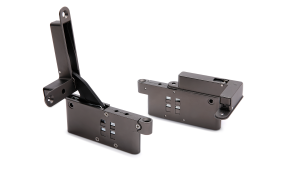Cabinet doors are an essential feature in modern bathrooms and kitchens, providing both functionality and style. One of the key components that allows these doors to swing open and close smoothly is the pivot hinge. Specifically, a concealed pivot door hinge offers a sleek look, enhancing the overall aesthetic of your space. If you’re experiencing issues with your cabinet door, knowing how to replace a pivot door hinge for a cabinet door can save you time and money. This article will guide you through the process step-by-step.
Smooth Operation of Pivot Hinges
A pivot door hinge is designed to allow the door to pivot from a single point at the top and bottom, rather than swinging from traditional side hinges. This design not only creates a modern look but also allows for smoother operation. Concealed pivot door hinges are hidden from view when the door is closed, further contributing to a clean and streamlined appearance.
Why Replace a Pivot Hinge?
Over time, pivot hinges can wear out due to constant use and exposure to moisture. Common signs that it’s time for a replacement include difficulty in opening or closing the door, visible rust or corrosion, or the door becoming misaligned. Replacing a damaged hinge will restore the door’s functionality and maintain the aesthetic appeal.
Tools and Materials Needed
Before starting the replacement process, gather the following tools and materials:
- New concealed pivot door hinge
- Screwdriver (Phillips or flathead, depending on your screws)
- Level
- Measuring tape
- Silicone sealant (optional)
- Cleaning cloth
Having these items on hand will make the replacement process smoother and more efficient.
Step-by-Step Replacement Process
- Remove the CabinetDoor
To begin, carefully lift the cabinet door off its hinges. It may be helpful to have a second person assist you, as cabinet doors can be heavy and awkward to handle. Once the door is removed, place it on a soft surface to prevent scratches.
- Remove the Old Pivot Hinges
Locate the screws securing the existing pivot door hinge for the cabinet door. Use your screwdriver to remove these screws carefully. If the hinge is stuck due to rust or corrosion, you may need to use a penetrating oil to loosen it. Once the screws are removed, take out the old hinge.
- Install the New Concealed Pivot Door Hinge
Position the new concealed pivot door hinge in the same location as the old one. Use the measuring tape to ensure proper alignment. Secure the hinge in place by inserting and tightening the screws. It’s important to make sure the hinge is level for optimal door operation.
- Rehang the CabinetDoor
With the new hinge installed, carefully lift the cabinet door back onto the pivot hinge. Ensure that it pivots smoothly and aligns correctly with the frame. This step may require some adjustments, so take your time to ensure everything is positioned correctly.
- Test the Door
Once the door is rehung, test its operation. Open and close the door several times to ensure the new pivot door hinge for the cabinet door is functioning properly. If the door appears misaligned or doesn’t swing smoothly, you may need to adjust the hinge slightly.
- Seal and Finish
If necessary, apply silicone sealant around the hinge area to prevent water from seeping in. This step is particularly important in a wet environment. Lastly, clean any fingerprints or residue off the door and surrounding area for a polished finish.
Conclusion
Replacing a pivot hinge on a cabinet door is a manageable task that can significantly improve the functionality and look of your bathroom. By using a concealed pivot door hinge, you maintain the modern aesthetic while ensuring durability. Whether you’re a DIY enthusiast or a first-time homeowner, following these steps will help you successfully replace your pivot door hinge for a cabinet door. With a little patience and the right tools, you can restore your cabinet door to its full potential, enhancing both its beauty and usability.
